A house fire can be a devastating event. Not only is your home likely to be destroyed, but you and your family may also be injured or worse.
According to the National Fire Protection Association, there are an average of 365,000 house fires in the United States every year.
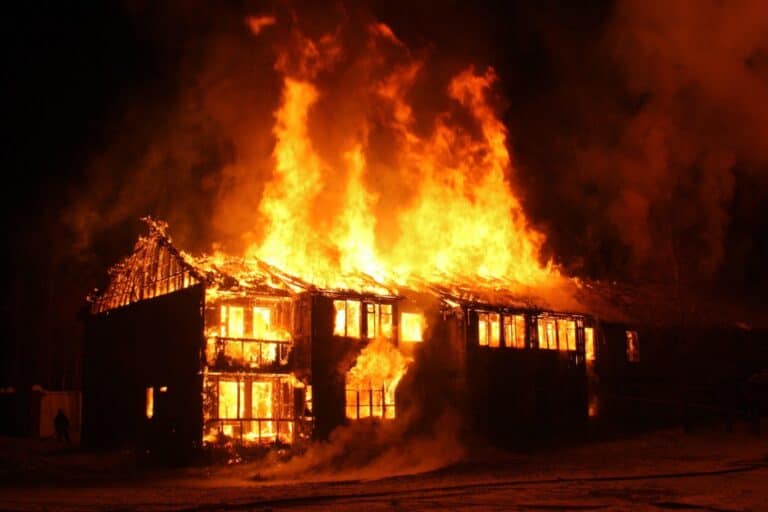
These fires cause over 3,500 deaths and $6.5 billion in property damage. The good news is that most of these casualties and losses are preventable.
In a matter of seconds, a little unintentional fire might go from being an alarming but simple problem, one you can handle, to a towering inferno with temperatures approaching 600 degrees zero visibility.
Each year thousands of people are overcome by the heat and smoke, perishing. You cannot let that happen.
You must know how to deal with housefire before it gets out of control, and how to get out before it is too late! In this article post, we will discuss how to survive a house fire and create a family fire escape plan!
Table of Contents
How Much do Housefires Cost Each Year?
Anyone reading this should understand instinctively how deadly a house fire is. That being said, you may not know the true toll that house fires inflict when it comes to cost in lives and material.
It’s useful to understand the cost of these fires in terms of both lives and property each year in the United States to better grasp how widespread the issue is. This is one disaster that is most likely to occur!
When you look at the nearly 400,000 yearly house fires in the United States, you’ll find that they cost a little over $7 billion dollars in damage, kill more than 2,500 people, and injure many 10’s of thousands more.
The vast majority of house fires result in the loss of all of a structure’s contents, even if the structure is not completely destroyed by the ensuing fire. Everything you have inside your home might literally be ruined ash after a fire.
This is especially terrible for preppers. All of your painstakingly prepared supplies, every piece of gear, every item or provision you had plan and save in order to acquire, and all of the resources you had on hand for dealing with a disaster… lost, gone, utterly.
Remember that your home may catch on fire just as the beginning of a greater context event. It might be the first and terrible chapter alone in your survival story!
It would be an awful way to start, without question. But all that you can do is the best you can. With some luck, you may douse a housefire with minimal damage.
If you aren’t that lucky, you can still escape with your lives if you have a sound, practiced plan.
Most Common Causes of a House Fire
- Cooking: cooking fires often happen due to leaving food on the stove or in the oven, or when cooking with a lot of grease (turkey fryers). If a fire starts when frying food in grease, put a lid on it and turn off the heat. Do not use water. It will make the fire worse. If a fire begins in the oven, close the door and turn off the heat. Don’t leave food unattended. Be careful when frying with grease.
- Smoking: If you’re a smoker, see your doctor about quitting. There are a lot of resources out there to help make it happen. In the meantime keep smoking materials (cigarettes, pipes, lighters, matches, etc.) out of children’s reach. Do not smoke in bed. Falling asleep while smoking causes a lot of fires.
- Heating Equipment: If you rely on portable electric heaters, be vigilant about safety. Look for automatic shut off for safety. Keep your heaters at least two feet from anything that can catch fire (curtains, beds, desks, etc.). Get your furnace inspected once a year to ensure it is working to the safety standards.
- Electricity: Check all of your appliances in your home – anything that plugs in. Inspect the wires and cables and plugs for any frays. If found, immediately replace the cord or entire appliance. Avoid overloading the circuit breaker. It can only handle so much. Overusing electricity can cause a fire. Best to keep it to a minimum. Have your electrical system inspected once a year to ensure safety. An electrician can inspect your system for any frayed wiring, damaged outlets, and any other hazards, as well as give you some custom tips.
- Clothing Dryers: These things cause a lot of home fires. The problem arises when the lint and dust builds up, which is why there is a lint remover on your dryer. Lint is extremely flammable. It can get clogged in the dryer and exposed to high heats – the perfect storm for a fire. Prevent fires by cleaning the lint trap before and after every use, and by checking the dryer vent area and cleaning it out as needed.
- Candles: Candles aren’t as romantic as you think. They’re dangerous and a leading cause of house fires. The simplest solution is to avoid candles completely. However, if you must use them, never leave a lit candle unattended and keep them away from anything that could catch fire.
You must have the necessary fire survival items in your home, as well as knowledge on what to do in the event of a fire. You must create a home fire escape plan with everyone you live with, little ones included.
And you need to practice your fire escape plans on a regular basis with everyone in your home. You work as a team so everyone knows what to do in the event of a home fire.
There are several steps to being prepared for a house fire, first with must-have fire escape items to keep at home, at your bug out location, and even take some with you when you stay in hotels or at a relative’s house.
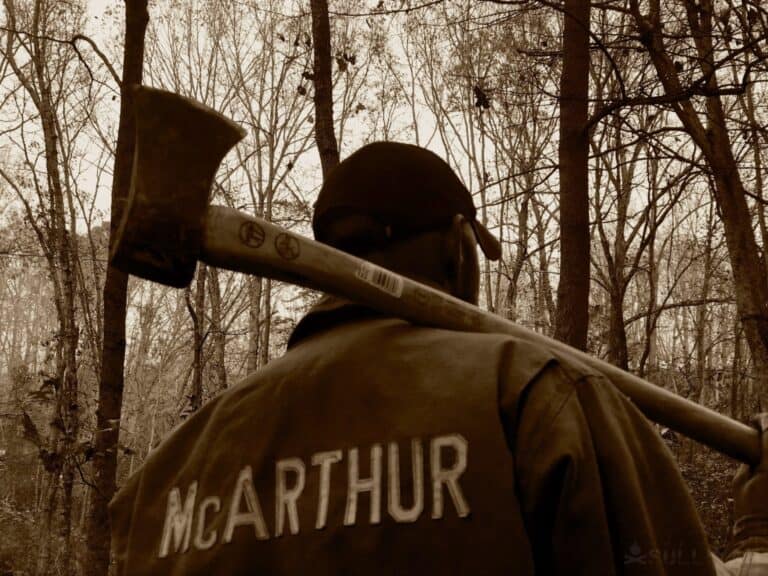
Understanding the Hazards of a House Fire
One of the ways you can prevent tragedy is to know and understand the hazards associated with house fires. House fires produce heat, smoke, and toxic gases.
Heat is the iconic danger of a fire as it can cause clothing to ignite and burn you directly. Smoke contains poisonous gases which can overcome people very quickly and are in fact the most dangerous part of the event.
Toxic gasses are released as a result of burning materials and possessions, many of them just as dangerous as the smoke itself.
House fires are capable of reaching daunting intensity, and they can swiftly go out of control.
You’ll need to know what you’re up against before you can devise a successful strategy for escaping or battling a house fire. You need to know how a fire reacts, what it does, how it behaves.
What the obstacles are to escaping safely. More significantly, you must know what to expect so that you don’t freeze or panic when in a time-is-life situation.
Consider the following factors before we move on to the planning phase…
Intensity
It’s an under-statement to claim that fire is scorching. A house fire can reach a maximum of several hundred degrees in a matter of seconds once it is underway.
Understanding the principles of heat is crucial for developing your house fire survival strategy. The temperature near the floor may be approximately 100 degrees, quite warm! But it could be as much as 600 degrees at neck and head level.
Any exposed skin will suffer instantly from this ferocious heat, but breathing superheated air damage your lungs and melt synthetic materials right to your body.
Low Visibility
You might believe that knowing where you are going in your own home would be the last thing on your mind during a house fire because your entire home is full of light sources and is well known to you.
Nothing could be further from the truth! House fires produce enormous quantities of black smoke and toxic gasses that can quickly reduce visibility to near nothingness. In the middle of the night your own home could be turned into a labyrinthine, black maze!
It is easier than it seems to get disoriented in one’s own home. If you cannot rely on sight you’ll need your sense of touch to guide your way around.
Speed
A single candle’s flame might quickly develop into a fully involved, out-of-control house fire in just 30 seconds. In half a minute, the room will be filled with black smoke and the entire home will be on fire.
You might not be aware of the fire until well after this point if you are sleeping or distracted. When fully out of control, the house fire will spread with rapidity, further emphasizing the need for swift, sure escape.
Lethality
A fire can kill you in two primary ways, each of them horrible.
While the concept of dying by burning to death is horrible beyond imagining, you have only a 30% chance of this happening in a housefire. It’s most often the smoke and poisonous gases produced by a burning home that end your life.
One or two big gulps of this toxic miasma from a burning structure might cause dizziness or even incapacitation. You are almost certainly doomed if you pass out from smoke inhalation while trapped inside a burning structure.
Now that you know what a house fire does and how it behaves, you’ll be better able to strategize your way out.
Fire Escape Plan Preparation
Sometimes, despite your best efforts to keep yourself safe and prevent a fire from occurring entirely, it fails.
It might be a simple accident or entirely unavoidable and unforeseen equipment failure. Maybe it is something no one could stop, a bolt of lightning or the work of an evil arsonist.
Whatever the cause was, you should make certain preparations in order to improve your chances of escaping or controlling the fire if necessary.
The following recommendations and procedures are provided by the Federal Emergency Management Agency (FEMA) and the United States Fire Administration to assist you get out of a house fire with your lives and most of your hair intact.
Get Fire Extinguishers
If you don’t have a fire extinguisher, preferably several, in your house, you’re planning to fail, not even trying.
Make sure you have at least two large ABC rated fire extinguishers on hand. If the fire is only minor, a fire extinguisher may be enough to put it out decisively.
A fire extinguisher may be the only instrument that can allow you to buy yourself a tiny amount of time by fighting an already massive blaze. Keep your fire extinguishers maintained and operational.
Install, Test and Maintain Smoke Detectors
It’s almost a law that you need to have working smoke alarms installed in or near every occupied room of your home.
Make sure they’re in good working order, test them at least once a month, and change the batteries regularly. Networked smoke alarms are a smart technological upgrade you might want to consider investing in.
his means that all of the detectors in the house will go off at once if any single one detects a blaze, as long as there is enough signal coverage throughout your property. If the fire starts outside the detection range of one or more detectors, this can offer you early notice.
Learn to Get Out by Touch Alone- It can’t be overstated how dark and impenetrable it will be when your house catches fire, even at midday with half the structure burning.
You should be able to navigate your way out of your home without relying on sight alone by using walls, corners, door frames, and other tactile “landmarks” as guides. This ability might save your life, so make sure you practice it!
Function Check and Clear All Windows and Doors
Make sure all door and window hardware is simple to operate under duress. It’s critical that all doors and windows open readily and completely so you can flee quickly in the event of a fire.
A tough deadbolt, a stuck latch on a window, or any other form of security mesh or bars could suffocate you and lead to your death.
Keep Escape Paths Clear
Don’t let anything block your escape route. Overgrown plants like trees and bushes, decorations, children’s toys, and other objects may be deadly stumbling blocks and harm if you have to flee through a door or window fast.
Keep all pathways leading away from your property, including emergency exits via windows, clear of obstacles. Take care if choosing thorny or hazardous plants for plating around the perimeter of your home.
Check First Responder Route
Take a stroll down the street that leads up to and immediately in front of your home. Is your house easily visible from the street? Is the house number clearly legible at both day and night?
If the road or path to your property is not easy to see, reflectors, new digits, paint, and so on might be useful. This ensures that emergency responders can swiftly locate your home after calling for aid.
Make a Fire Escape Map
Let’s be honest: Do you really require a map to your own house? Is there anywhere else you are more familiar with than your very own home and hearth?
That isn’t the point; the goal is to draw a scale map of your home so that you can show how to flee and better visualize your planning phase. This is an essential step when it comes time to plan and execute escapes with your family.
Every room in your home should have at least two escape routes, one leading outside or through a window that everyone in the household may squeeze through.
Prepare for a Challenging Escape
You may not have a choice in a two-story house but to flee via an 2nd or 3rd floor (attic) window. Instead of taking the risk of sustaining a badly broken bone in a fall, invest in fire escape ladders.
Fire escape ladders are lightweight, telescopic devices that are simple to use with some practice and will allow you to flee from an upper-story window quickly and simply.
Any sharp or prickly plants beneath windows on the first floor should be avoided.
They’re fantastic for both ornamental and defensive reasons, but they can tangle you up and snag you if you get into them. A heavy blanket is useful for this purpose.
Craft Plans Around the Least Capable Family Members
If you have anyone with restricted mobility in your home, such as babies, old folks, disabled or anybody who has physical restrictions, be sure someone else from the family helps them get out of the house or otherwise assists them.
Make sure to include an alternate helper in your plans if the initial rescuer isn’t available or absent.
Pre-plan Rendezvous Points
After they’ve left the house, all members should know where to go and regroup. This could be the end of the driveway, a lamp post, a neighbor’s home, or anyplace else.
Go Over Your Plan with Family
Make sure everyone understands how to get out of every room, both routes, and can do so without help in the case you are unable to locate them during a fire.
Make sure everyone knows where they’ll go, what they’ll do and how to respond if there’s a house fire. Make sure everyone has their questions and concerns addressed.
Rehearse and Rehearse Again!
Drill the various permutations of your fire escape plan, starting at various locations in the home. To increase realism, progress through a simple-intermediate-advanced technique.
Begin with a daylight drill without any additional distractions. Then repeat the exercise but while crawling.
After that, put up with as much stress as possible by doing a surprise nighttime drill (after warning your family ahead of time, of course!) Increase the stress by setting off smoke alarms and using other simulators.
Consider a Bail-Out Bag
Place your bug-out bag near a junction between several escape routes or in the master bedroom for the best chance of retrieving it as you leave the house.
Make sure your BOB is packed with anything that is genuinely irreplaceable, such as documents and foodstuffs.
It does not have to be the end of the world for your BOB to be useful: if everything you own was lost, at least you’d be glad to have what supplies and rations are inside it!
Step-by-Step Fire Escape Procedures
Find two ways out of each room in your home. Verify that everyone knows where escape ladders are and how to leave the house most quickly.
Plan for a meeting place your family can easily run to once they evacuate that is far enough away from the house to be safe, like the end of your block.
Twice a year, gather everyone in your household and go over escape procedures. Make sure no windows are stuck and that screens can be easily removed or kicked out. Close your eyes and practice feeling your way out of the house in order to best mimic the sightless conditions of a house fire.
Take photos and videos of your home inside and out. Keep these on file in several locations in case of a fire. You will need to show your insurance company the before and after.
Step 1: Act Quickly
Crawl along the floor and get to the exit quickly. Heavy smoke and poisonous gases gather along the ceiling first so sticking to the ground is important.
Step 2: Check the Doors before Moving on
Feel the doorknob and the door itself. Is it hot to the touch? Is there smoke pouring out from under it? If so, find a different way out.
Step 3: Avoid Smoke Inhalation
Wrap your shirt around your mouth and nose as soon as you smell smoke. Tie it off around your head so you can use both hands to crawl to the exit quickly.
Step 4: Avoid Items Highly Likely to Catch Fire
Curtains, tablecloths, bedding, and any other cloth materials catch fire easily. Rooms with a lot of upholstered furniture will go up in flames first so either avoid living rooms and bedrooms or go through them very quickly if safe.
Step 5: If Your Clothes Catch Fire
Stop, drop and roll. Cover your face with your hands and roll back and forth until the fire is extinguished. If someone else is on fire, smother the flames with a fire blanket or a piece of your own clothing.
Step 6: If You Are Trapped
This is a last resort, because you must get out and away from the fire. However, sometimes people get stuck due to the fire and smoke. If this happens, close any doors and top up any cracks or vents with tape or cloth to keep smoke out.
Call 911 and tell them you are trapped and approximately where in the house you are. Get to a window and use something to signal where you are so firefighters can get to you as soon as possible.
Step 7: Getting Out
Stay out of the house. If there are any pets or people left inside let the firefighters know — they have experience on how to get in and out safely and you do not. Rely on emergency services to help you.
What to do After the Fire
Get to safety at your bug out location.
Once safe, notify your insurance company immediately. They can help you with the next steps like emergency funds, how to inventory for loss, and fire restoration companies.
Send them your photos and videos of the inside and outside of your home. Make sure to also notify your mortgage company if you are a homeowner, landlord if renting.
Your fire department will let you know when your home is safe to reenter. They will also verify that utilities are safe to use or safely disconnected.
Save any receipts for food, hotels, etc. that you accrue so your insurance company can reimburse you.
15 Must-Have House Fire Escape Items
There are many items you can get to help aid you in the event of a house fire. These are the top 10.
#1: Smoke Detectors
The number one item you must have in your home in order to survive a house fire is a smoke detector.
Firefighters cite not having smoke detectors, or not having working smoke detectors, as the number one cause of house fire deaths in the country.
If you’re sleeping and a fire starts up in another room in your home your smoke detector will alert you.
However, if you don’t have any smoke detectors, or have smoke detectors that don’t work, you may die in your sleep never knowing there was a fire.
So, your number one must-have house fire escape items are functional smoke detectors. Install one in each room of your home. Some say you only need one in the kitchen and one in or near each bedroom.
If you’re serious about surviving a house fire, install one in each room – every bedroom, your living room, your kitchen, your bathroom, your hallways, and in your basement. Why do just the minimum on something so serious?
Now, you can’t just install these smoke detectors and forget about them. Set a reminder to test them once a month. Replace the batteries in them twice a year during daylight savings time.
When you set your clocks back an hour or forward an hour, replace those batteries, even if they are still working. If the battery dies, you die and your family dies.
#2: Fire Alarms
Fire alarms alert the fire station when there is a fire in your home. Every second is crucial.
The sooner the firefighters know there is a fire somewhere, the sooner they will get to you to start putting the fire out and pulling people and pets out of the home.
#3: Sprinkler Systems
Most homes don’t have sprinkler systems because they are a bit more expensive than the minimum.
But how much is your life worth? Your spouse’s? Your kids? Businesses of all sizes have sprinkler systems to start putting out a fire the second the system is alerted.
The sprinklers are installed in the ceilings. When they are alerted to a fire they will sprinkle water all over the room, stopping the fire before it gets out of control. It’s an investment, but can be well worth it.
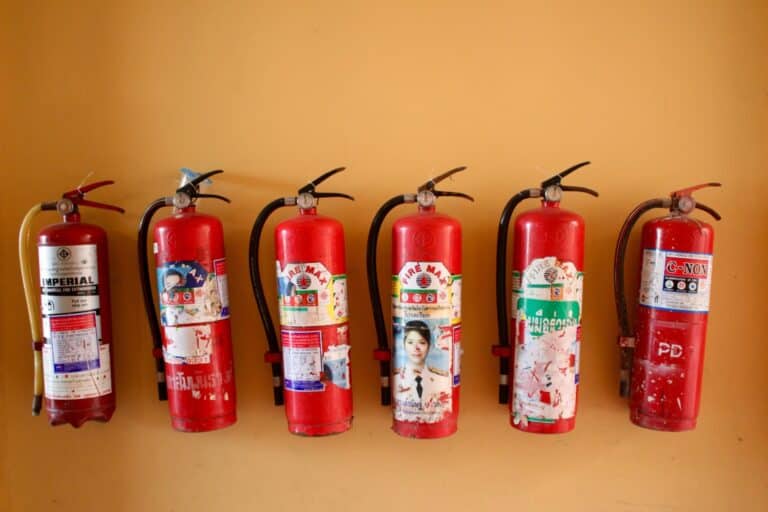
#4: Fire Extinguishers
Most home improvement stores, “big box” stores and online retailers offer fire extinguishers in various sizes. They should be easily accessible and stored in any part of your home that has the potential for fire like in kitchens, on the patio if you have a barbecue, etc.
It is important to have one on every floor of your home. Be mindful that fire extinguishers come with an expiration date. You can have them serviced or recharged at almost any fire station.
#5: Emergency Rope Ladders
Rope ladders are escape ladders that are ready to hook onto a window ledge or balcony and drop down to the ground. Ladders come in all sorts of materials, like wood and metal, and in lots of different lengths.
Make sure the kind you get for your home is long enough for a safe descent. They should be stored near bedroom windows so you know just where they are in emergencies.
#6: Fire Blankets
Fire blankets can be used to kill fires by cutting off its oxygen supply that it needs to keep going. You can also use them to wrap yourself up while escaping.
The blankets are made of malleable fiberglass and can withstand temperatures of up to around 900 degrees F.
Like fire extinguishers, these should be stored in a cool, dry place anywhere near potential fire hazards. Replace the blanket after each use.
#7: Fire Retardant Paint and Flame Resistant Clothing
Fire retardant paint and flame-resistant clothing are often the first line of defense against a home in flames. While it doesn’t stop or smother fire it does slow its progress.
The paint is made an intumescent paint and different types can be used on different home building materials so be sure and verify on the label if it can be used on wood, sheetrock, metal, etc.
Flame-resistant clothing is made of material that pushes oxygen away, thereby starving the fire. Most sporting goods stores carry such clothing.
#8: Fire Safety Signs
Fire exit signs and fire safety equipment signs are a smart idea. In a house fire, even the most rehearsed person can panic.
Signs remind people where the exits and where things like fire extinguishers, emergency ladders, and fire blankets are.
#9: Extension Cords with Fire Shield
These cords are able to detect faults that can lead to fires due to specially designed and shielded conductors.
Surge protectors and power strips greatly reduce the impact of fires. These should be used with any major appliances in your home and, if possible, with anything electrical.
#10: Fireproof Safe
Safes come in different sizes as well as different ratings for fire safety.
Get one that is highly rated as well as large enough for paperwork like passports, mortgage paperwork, loan paperwork, data storage, wills, licenses, and anything sentimental.
Before purchasing a safe, it is a good idea to gather up everything you want to store to get an idea of the size you need. Make sure to consider where you want the safe to be stored as the flooring must be able to withstand the weight.
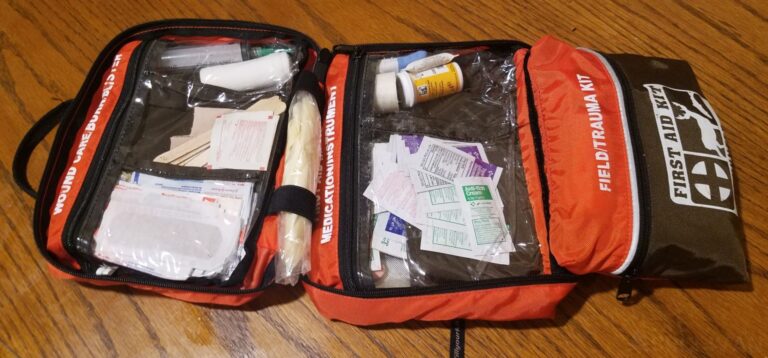
#11: First Aid & Fire Kit
Keep a first aid kit at your outdoor meeting place. You may get injured when escaping a fire.
Your emergency first aid and fire kit must include all of the standard items for a first aid kit plus burn cream, burn gel, conforming gauze for burns, and skin dressings for blisters.
#12: Rescue Alert Window Stickers
Home improvement stores and your local firehouses will have these in stock. The stickers are iridescent markers to place in high visibility of windows. Often they can be marked with how many people or pets are in the home.
#13: Emergency Go Pack
Each person in the house should have their own emergency go pack. There should be enough water and non-perishable foods for a few days along with batteries, a flashlight, and pet supplies if applicable.
You can make a pack out of any hearty satchel or even a nylon drawstring bag.
In at least one of the packs there should be a flash drive with photos of each room in your home, and of every valuable along with snapshots of the paperwork stored in your safe.
#14: Rapid Evacuation Device
This is a bag and nylon rope made out of fire retardant materials. It’s used to evacuate babies and small children safely from second stories or higher. It comes ready to go in its pouch.
Open, place child inside, and zip before lowering them to safety. Keep these in the nursery near the window, preferably where you keep the fire blanket.
#15: Emergency Escape Mask
These masks are made of a fire-resistant plastic that slips over the head and neck like a fireproof hood. They are meant to be used one time.
Escape masks allow for temporary resistance to smoke and noxious gases. These are good to keep in a first aid kit and to even keep in your car.
Wrap Up
Surviving a house fire is by and large about prevention. Having working smoke alarms and fire equipment that is kept up to date and tested often as well as practicing escape plans means that it is possible to survive a fire.
Practice mindfulness every time you engage with fire or electricity in any fashion and rest easy knowing that if you’ve followed all of these steps you are as safe as anyone can expect to be.
Above all, remember that things are replaceable and you are not.
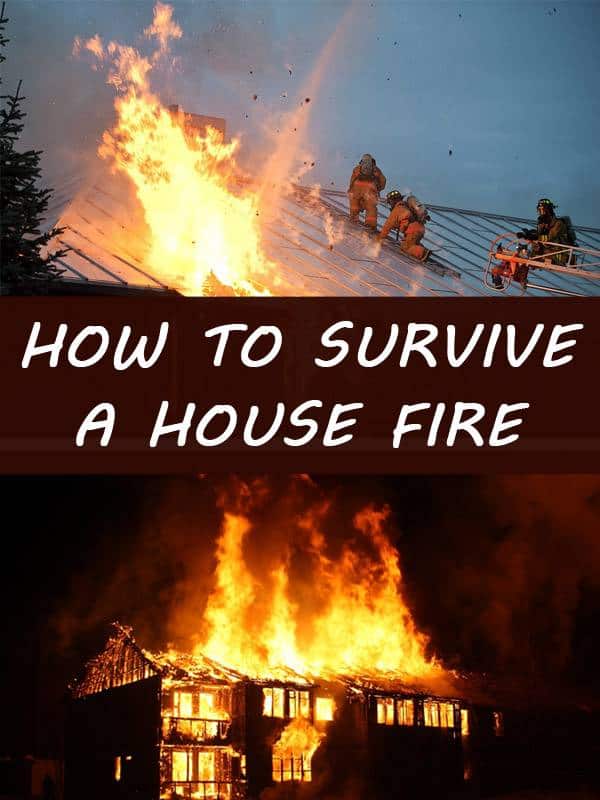

My dad was military. My grandfather was a cop. They served their country well. But I don’t like taking orders. I’m taking matters into my own hands so I’m not just preparing, I’m going to a friggin’ war to provide you the best of the best survival and preparedness content out there.

Excellent article. Covered all bases but one. As a retired firefighter of 38 years, another important item is to keep doors to other rooms closed at all times, especially at night while sleeping. A closed door will keep the smoke, heat, and fire from spreading for a longer time than you think. You can have a living room fully involved in fire and if doors are closed have a completely clean and undamaged bedroom next to it. Buys you time to get out. And close any exterior doors if you evacuate as the airflow into the house will feed the fire.
Hi John,
Yes, closing the interior doors is important for possibly keeping a fire contained. Thank you for the addition, and thank you for your service.